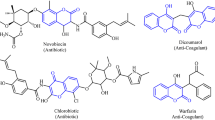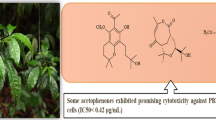Abstract
Considering the potential interest of heterocyclic compounds, the aim of the present study is to synthesize new coumarin derivatives, to provide their full chemical characterization and to evaluate their antimicrobial activities. The reaction of ethyl 2-(4-methyl-2-oxo-2H-chromen-7-yloxy) acetate 2 with sodium hydroxide afforded the corresponding 2-(2-oxo-4-methyl-2H-chromen-7-yloxy) acetic acid 3 which was esterified using a series of alcohols in the presence of iodine to yield a new series of coumarin esters 4a–j. On the other hand, treatment of the key intermediate 2 with an aqueous solution of hydrazine in ethanol at reflux gave the corresponding hydrazide 5 which further converted into coumarin derivatives 6a–f and 7a–c by condensation with a series of aromatic aldehydes and cyclic anhydrides, respectively. The synthesized compounds were completely characterized by 1H NMR, 13C NMR, IR and HRMS. The antibacterial and antifungal activities of the new synthesized compounds were evaluated using the disc diffusion method and seemed to be significant.



Similar content being viewed by others
References
Abd El-Fattah M, El-Kady MY, El-Rayes SM, Mohammed MK (2011) Synthesis and biological evaluation of some coumarin derivatives. Rev Chim 62(9):881–883
Abdel-Aziz HA, Hamdy NA, Farag AM, Fakhr IMI (2007) Synthesis and Reactions of 3-Methylthiazolo[3,2-a]benzimidazole-2-carboxylic Acid Hydrazide: synthesis of some new pyrazole, 1,3-thiazoline, 1,2,4-triazole and 1,2,4-triazolo[3,4-b]-1,3,4-thiadiazine derivatives pendant to thiazolo[3,2-a]benzimidazole Moiety. J Chin Chem Soc 54:1571–1582
Al-Amiery AA, Mohammed A, Ibrahim H, Abbas A (2009) Study the biological activities of tribulus terrestris extracts. World Acad Sci Eng Technol 57:433–435
Al-Amiery AA, Al-Bayati R, Saour K, Radi M (2011a) Cytotoxicity, antioxidant and antimicrobial activities of novel 2-quinolone derivatives derived from coumarins. Res Chem Intermed 38:559–569
Al-Amiery AA, Musa AY, Kadhum AAH, Mohamad AB (2011b) The use of umbelliferone in the synthesis of new heterocyclic compounds. Molecules 16:6833–6843
Al-Amiery AA, Abdul Amir HK, Abu Bakar M (2012) Antifungal activities of new coumarins. Molecules 17:5713–5723
Barry AL, Thornsberry C (1991) Susceptibility test: diffusion test procedures. In: Balows Hausler A, Herramann WJ, Isenberg HD, Shadomy HJ (eds) Manual of clinical microbiology. American society for microbiology, Washington
Borges F, Roleira F, Milhazes N, Santana L, Uriarte E (2005) Simple coumarins and analogues in medicinal chemistry: occurrence, synthesis and biological activity. Curr Med Chem 12:887–916
Emmanuel-Giota AA, Fylaktakidou KC, Hadjipavlou-Litina DJ, Litinas KE, Nicolaides DN (2001) Synthesis and biological evaluation of several 3-(coumarin-4-yl)tetrahydroisoxazole and 3-(coumarin-4-yl) dihydropyrazole derivatives. J Heterocycl Chem 38:717–722
Gammon DW, Hunter R, Wilson SA (2005) An efficient synthesis of 7-hydroxy-2, 6-dimethylchromeno [3,4-d] oxazol-4-one-a protected fragment of novenamine. Tetrahedron 61:10683–10688
Ganesh RK, Prarthana VR, Sandeep G, Saurabh A, Arunima V, Atin K, Suresh T (2010) Synthesis and in vitro evaluation of novel 1, 2, 4-triazole derivatives as antifungal agents. Lett Drug Des Discov 7:46–49
Harvey RG, Cortez C, Ananthanarayan TP (1988) A new coumarin synthesis and its utilization for the synthesis of polycyclic coumarin compounds with anticarcinogenic properties. J Org Chem 53:3936–3943
Jereb M, Vrazic D, Zupan M (2009) Dual behaviour of alcohols in iodine-catalyzed esterification under solvent-free reaction conditions. Tetrahedron Lett 50:2347–2352
Kabalka GW, Mereddy AR (2005) Microwave enhanced cross-coupling reactions involving potassium organotrifluoroborates. Tetrahedron Lett 46(37):6329–6331
Kadhum AH, Mohamad A, Al-Amiery AA (2011) Antimicrobial and anti-oxidant activities of new metal complexes derived from 3-aminocoumarin. Molecules 16:6969–6984
Keri RS, Hosamani KM, Shingalapur RV, Reddy HR (2009) 2-Azetidinone derivatives: design, synthesis, in vitro antimicrobial, cytotoxic activities and DNA cleavage study. Eur J Med Chem 44(12):5123–5130
Kostova I, Raleva S, Genova P, Argirova R (2006) Structure-activity relationships of synthetic coumarins as HIV-1 inhibitors. Bioinorg Chem Appl 68274(1–68274):9
Kumar T, Dewangan D, Alexander A, Nagori K, Tripathi DK (2011a) Synthesis and characterization of 8-[(2-amino-6-aryl-pyrimidin-4-yl) oxy]-4-methyl-2H-chromen-2-ol derivatives. Asian J Biochem Pharm Res 2(1):2231–2560
Kumar G, Kumar D, Devi S, Verma R, Johari R (2011b) Synthesis, spectral characterization of biologically active compounds derived from oxalyldihydrazide and 5-tert-butyl-2-hydroxy-3-(3-phenylpent-3-yl)benzaldehyde and their Cu(II), Ni(II) and Co(II) complexes. Int J Eng Sci Technol 3:1630–1635
Lin PY, Yeh KS, Su CL, Sheu SY, Chen T, Ou KL, Lin MH, Lee LW (2012) Synthesis and antibacterial activities of novel 4-hydroxy-7-hydroxy- and 3-carboxycoumarin derivatives. Molecules 17:10846–10863
Manolov I, Danchev ND (1995) Synthesis, toxicological and pharmacological assessment of some 4-hydroxycoumarin. Eur J Med Chem 30:531–536
Marmonier A (1987) Antibiotiques Technique de diffusion en gélose méthode des disques. Bactériologie médicale Techniques usuelles. SIMEP, Paris, pp 237–243
Messaoudi S, Peyrat JF, Brion JD, Alami M (2010) An expeditious copper-catalyzed access to 3-aminoquinolinones, 3-aminocoumarins and anilines using sodium azide. Adv Synt Catal 352:1677–1687
Morimoto M, Tanimoto K, Nakano S, Ozaki T, Nakano A, Komai K (2003) Insect antifeedant flavonoids from gnaphalium affine. J Agric Food Chem 51:1888–1891
Ramalinga K, Vijayalakshmi P, Kaimal TNB (2002) A mild and efficient method esterification and transesterification catalyzed by iodine. Tetrahedron Lett 43:879–882
Ramesh P, Das AT, Mohandass P, Nagasathya R (2008) The structure of hantzsch coumarin. Indian J Chem 47:1447–1450
Rice SA, Givskov M, Steinberg P, Kjelleberg S (1999) Bacterial signals and antagonists: the interaction between bacteria and higher organisms. J Mol Microbiol Biotechnol 1:23–31
Ronad PM, Noolvi MN, Sapkal S, Dharbhamulla S, Maddi VS (2010) Synthesis and antimicrobial activity of 7-(2-substituted phenylthiazolidinyl)-benzopyran-2-one derivatives. Eur J Med Chem 45(1):85–89
Santana L, Uriarte E, González-Díaz H, Zagotto G, Soto-Otero R, Méndez-Alvarez E (2006) A QSAR model for in silico screening of MAO-A inhibitors. Prediction, synthesis and biological assay of novel coumarins. J Med Chem 49(3):1149–1156
Singh I, Kaur H, Kumar S, Kumar A, Lata S, Kumar A (2010) Synthesis of new coumarin derivatives as antibacterial agents. Int J ChemTech Res 2:1745–1752
Srinivasan P, Rampally CS (2004) Synthesis of 7-hydroxy-4-methyl coumarin using polyaniline supported acid catalyst. J Mol Catal 209:117–124
Wu L, Wang X, Xu W, Farzaneh F, Xu R (2009) The structure and pharmacological functions of coumarins and their derivatives. Curr Med Chem 16:4236–4260
Author information
Authors and Affiliations
Corresponding author
Rights and permissions
About this article
Cite this article
Medimagh-Saidana, S., Romdhane, A., Daami-Remadi, M. et al. Synthesis and antimicrobial activity of novel coumarin derivatives from 4-methylumbelliferone. Med Chem Res 24, 3247–3257 (2015). https://doi.org/10.1007/s00044-015-1368-y
Received:
Accepted:
Published:
Issue Date:
DOI: https://doi.org/10.1007/s00044-015-1368-y




